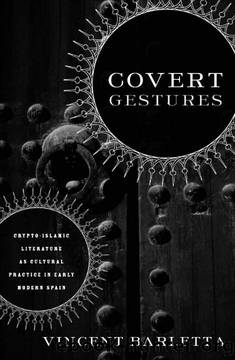Covert Gestures: Crypto-Islamic Literature as Cultural Practice in Early Modern Spain by Vincent Barletta

Author:Vincent Barletta [Barletta, Vincent]
Language: eng
Format: epub
Published: 2011-10-03T20:29:00+00:00
None of these note hands corresponds to that of the text. Also, there is a sloppiness to the writing, combined with certain orthographic errors (e.g., not connecting a medial yaa to the lam that follows it). From these features, we can conclude that these notes were not written by any alfaki or other learned Morisco. Rather, these notes reflect the at times playful back-and-forth of students reading the Libro de las luces as part of their religious education.
Little is known about the religious instruction of Castilian and Aragonese Moriscos, though we do know that it was general practice for crypto-Muslim parents to send their teenage boys to local alfakies to learn about Islam (Cardaillac 1979). It is also known that an important part of the teaching practices of these alfakies included literacy instruction in aljamiado, which implied the use of Islamic texts. In fact, a large number of extant aljamiado manuscripts speak to, inter alia, the instructional, socializing activities within which they were used. Such use is generally made evident through the didactic theme of the text itself (the Breviario cunni of Ica de Gebir and the literary output of the Mancebo de Arevalo being good examples of these).
In part through the socially embedded discursive practice of reading and writing, local alfakies worked to convert young boys into young Muslims. And what the lectoral notes at the bottom of folio 120" of BRAH ms. 11/9413 provide us with is concrete evidence of the use of narrative texts such as the Libro de las luces in the religious instruction of Morisco boys, as well as the use of the physical space within these books by students to mediate their own, less structured, discursive interaction. We cannot know with certainty whether the five boys who wrote in the margins of BRAH ms. 11/9413 were all present as they marked up the margins of this book, though it is possible to construct at least a hypothetical timeline for them. First, it is most likely, from its placement with respect to the text and the other notes - as well as its starkly different hand - that "karta" was the first note written on the folio. Afterward, someone seems to have added "Hoy daremos" before it to complete the phrase. The time between this first and second note might be significant; however, the temporal distance between the second and the remaining three notes seems to close considerably, as each refers to a temporal frame in the very near future or the recent past. The second note situates itself within a specific, though relative timeframe: "Hoy daremos" (Today we will give). The other notes, though quite possibly written on todays that differ from that of the first or second note, maintain the proximal and relative timeframe introduced by the second.
The third note seems to relate both to the text itself - which, as I have already mentioned, is about food - and to the reader's own desires. He writes " cena" (dinner), as though the
Download
This site does not store any files on its server. We only index and link to content provided by other sites. Please contact the content providers to delete copyright contents if any and email us, we'll remove relevant links or contents immediately.
| Anthropology | Archaeology |
| Philosophy | Politics & Government |
| Social Sciences | Sociology |
| Women's Studies |
Born to Run: by Christopher McDougall(6897)
The Leavers by Lisa Ko(6808)
iGen by Jean M. Twenge(5166)
Sapiens by Yuval Noah Harari(5125)
The Kite Runner by Khaled Hosseini(4956)
Spare by Prince Harry The Duke of Sussex(4794)
Bullshit Jobs by David Graeber(3837)
Machine Learning at Scale with H2O by Gregory Keys | David Whiting(3648)
Never by Ken Follett(3537)
Livewired by David Eagleman(3535)
Goodbye Paradise(3455)
Fairy Tale by Stephen King(2958)
A Dictionary of Sociology by Unknown(2858)
Harry Potter 4 - Harry Potter and The Goblet of Fire by J.K.Rowling(2814)
The Social Psychology of Inequality by Unknown(2770)
The Club by A.L. Brooks(2750)
People of the Earth: An Introduction to World Prehistory by Dr. Brian Fagan & Nadia Durrani(2620)
0041152001443424520 .pdf by Unknown(2603)
Will by Will Smith(2584)
